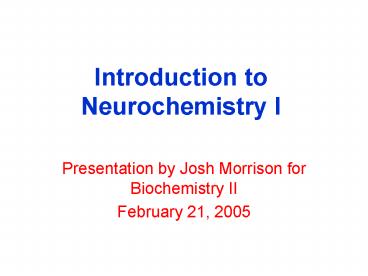Introduction to Neurochemistry I - PowerPoint PPT Presentation
1 / 26
Title:
Introduction to Neurochemistry I
Description:
Introduction to Neurochemistry I. Presentation by Josh Morrison for Biochemistry II ... Source of potential energy for transporting ions and molecules across cell ... – PowerPoint PPT presentation
Number of Views:180
Avg rating:3.0/5.0
Title: Introduction to Neurochemistry I
1
Introduction to Neurochemistry I
- Presentation by Josh Morrison for Biochemistry II
- February 21, 2005
2
The Membrane Potential
- Vm is the symbol for Membrane Potential
- Vm is the electrical charge of a cell
- Present in all cells
3
Importance of Vm
- Source of potential energy for transporting ions
and molecules across cell membrane i.e.
Na/glucose cotransporter - Determines if ion will be actively or passively
transported across membrane - Thus, to some extent, determines how cell will
spend energy
4
Origin of Vm
- Vm is complex interaction between ion
concentrations and the channels and pumps through
which ions enter and exit cell - To help understand the factors involved, let us
look at a simple cell with only one positive and
one negative ion
5
Simple Cell
- Recall physics. For electricity to exist, there
must be a complete pathway for electron flow. - Ioncharged particle (like electron). Thus, flow
of ions equals electric flow.
6
Simple cell cont
- Lets say that the positive ion flows through
channel from high concentration to low
concentration (selective permeability) - However, flow of charged particle causes
electrical charge of cell to shift (from neutral
to positive) - Shift in electrical properties of cell disfavors
flow of positive charge out of cell
7
Flow of ions in simple cell
Lecture 2 From Dr. James A. Murrays Website
http//faculty.uca.edu/7Ejmurray/BIOL4425/lec/lec
tures.asp
8
Nernst Equation
- Eion(RT)/(zF) log iono / ioni
- Or
- Eion58/charge log iono / ioni
9
Nernst Equation
- Predicts Vm value for cell whose membrane is
permeable to one ion - Example calculation for K
- EK 58/1 log 5mM / 125mM -81 mV
- Limits of Nernst
10
Wrap Up of Vm
- Real cells are permeable to many different ions
- Membranes permeability to ions major factor in
determining what Vm (illustrated by
Goldman-Hodgkin-Katz Eq.) - Thus, the most conductant ion will have the
greatest effect on Vm
11
Resting Potential
Lecture 2 From Dr. James A. Murrays Website
http//faculty.uca.edu/7Ejmurray/BIOL4425/lec/lec
tures.asp
12
Spike Initiation Zone
13
Myelin is actually Schwann cell wrapped around
axon multiple times
14
The Action Potential
15
Action Potentials
- Mode of Communication in Neurons
- Intensity (frequency) determines magnitude of
response - Initiation-Propagation-Termination
16
Initiation
- Occurs only in SIZ
- Initially, only leak channels open (K)
- Slight depolarization to threshold opens
Voltage-gated Na channels (VGNaC) - Na flows with electrochemical gradient, causing
further depolarization - All-or-none response
17
Action potential initiation
S.I.Z.
Lecture 5 From Dr. James A. Murrays Website
http//faculty.uca.edu/7Ejmurray/BIOL4425/lec/lec
tures.asp
18
Propagation
- Local Circuit CurrentsNa diffuses down axon and
depolarizes other places in axon - AP Initiate in these nearby areas
- Saltatory conduction of AP due to myelin
19
Propagation
Lecture 5 From Dr. James A. Murrays Website
http//faculty.uca.edu/7Ejmurray/BIOL4425/lec/lec
tures.asp
20
VGNaC found only on the nodes
Potassium leak channels present throughout neuron
Voltage Gated K channels also in area around node
21
Termination
- VGNaC inactivatecause repolarization
- At the same time, the depolarization has cause
VGKC to openspeed repol - Flow of K out of cell causes hyperpolarization
- Refractory Periodprevents backwards movement
of AP
22
Action potential termination
Lecture 5 From Dr. James A. Murrays Website
http//faculty.uca.edu/7Ejmurray/BIOL4425/lec/lec
tures.asp
23
Ig loop (H-gate)
24
Role of S4 helix in gating
http//wilkes-fs1.wilkes.edu/terzaghi/BIO-226/lec
tures/13.html
25
Activation of sodium channel through S4 movement
(M-gate)
Outside
depol
Cytosol
Ready state No Na entry (Vm-70 mV)
Active State Na enters (Vmthreshold)
time
26
H-gate inactivates sodium channel once Vm cytosol
becomes positive
Inactive
Ready
Active
Na
H-gate
M-gate
Lecture 5 From Dr. James A. Murrays Website
http//faculty.uca.edu/7Ejmurray/BIOL4425/lec/lec
tures.asp































